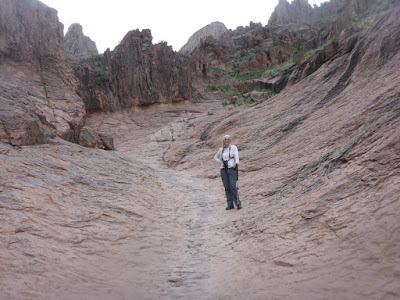It's a one hour drive south to Madera Canyon from Tucson, and we were up at 5 am to arrive at the trailhead at 7 am. Madera Canyon is famous for being the first spot in the United States to record an elegant trogon, a bird seen more often in Mexico. We've visited Arizona 7 times, and every time we've searched for and failed to see a trogon (we've seen plenty other kinds of trogons in Mexico, where they pretty much hang around in the trees waiting to be photographed). So I was a little surprised to see the elegant trogan listed on the Madera Canyon checklist as common in spring and summer. And we'd been skunked 7 times!
The lower canyon was still cool with the shade of large trees. But soon we heard first a Hutton’s vireo and then a definite warbler calling. I spotted a silhouette high in the canopy and we identified it as a red-faced warbler, a beautiful little bird, and a lifer for us. Then a different warbler song that we recognized as the painted redstart we saw last week in Ramsey Canyon.
Then Dorothea said, what's that chuck chucking sound? Leo thought it sounded like it might be a trogon, so he pulled out his tablet and played the song (ethically suspect these days, by the way), and right away I saw a large bird fly in nearby. Holy Grail, bagged.
But just because you see a lifer, it doesn't necessarily mean you get a decent picture.
Bird of the Day, even though I was actually more excited about the red-faced warbler.
Then we continued up the very steep trail into the pine trees, with ever improving views of the Santa Rita mountains and the deer plains below. We hoped to make it up to Agua Caliente Saddle, but it got hotter and less shady as we switched back and forth and we decided to save ourselves for another day, and headed back down the mountain.
Unlike some, we're always happy to pose.
We saw at least three kinds of pines on our hike:
These are my educated guesses (educated by google and the old Trees of North America guide)
Apache pine
Arizona white pine (P. stobiformis)
Mexican pinyon
Of interest to Dorothea were the various live oaks and this Arizona Madrona
Because of their similarity to the Garry oak and arbutus back home on Vancouver Island.
Back in the canyon, we stopped at Kubo and Santa Rita lodges to check out their popular bird feeders where we saw magnificent hummingbirds (2023 note: little did I know in 2017, but in that same year, they divided this hummingbird into 2 species and named the species that occurs in Nicaragua and north the Rivoli's hummingbird, and the magnificent hummingbirds we saw long ago (1994?) in Costa Rica are now the Talamanca hummingbird. Instant new lifer!), a Scott's oriole and a hepatic tanager. No decent photos of these rare (north of Mexico anyway) birds,
And on our way home we braved the scorching heat to check out a historical site, San Xavier del Bac, on the Tohono O'odham reservation. The mission was established in 1692 and the church constructed in 1783.

















































